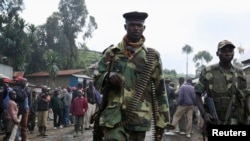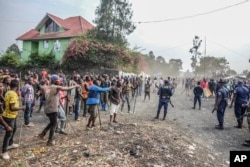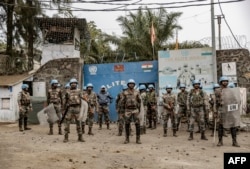Journalists have gone into hiding in fear for their lives in eastern Democratic Republic of Congo following increased attacks by rebel group M23, which controls the Bunagana area near the Rwandan and Ugandan borders.
One community radio station went off the air in mid-June, and two of its journalists later were detained for two days, ending with several hours of torture. They were told they’d be killed if they worked with the government army.
M23 accuses reporters and civilians of collaborating with government soldiers and informing them about the group’s positions and hideouts, journalists say.
In an interview with the Committee to Protect Journalists (CPJ) last week, a spokesman for M23 denied attacks on journalists.
The Voice of Mikeno (RACOM), a community radio station in Bunagana, was vandalized after M23 rebels took control of the key border town June 13.
That day, a transmitter, solar panels, computers and other equipment were taken, allegedly by M23 rebels. RACOM, a VOA affiliate, has been off the air since then, and all its 20-plus staff members are in hiding.
One RACOM journalist spoke to VOA’s Swahili Service after requesting anonymity to protect his safety.
Identified here as “Oscar,” he said he was detained by M23 members while interviewing residents in Nyakabande refugee camp in Kisoro, Uganda. He said he later learned from colleagues that another RACOM journalist, Henry Hererimana Serushago, was detained from the same camp on the same day.
The two journalists separately were taken back to Bunagana town. Oscar said the rebels tied up and whipped him for several hours before releasing him July 5, adding that he was told “to go and never continue working with the army.”
Serushago also was tied up, beaten, kicked and whipped – and threatened with death if he talked about the mistreatment, he told CPJ in an interview. He also was released July 5.
Like Oscar, Serushago is in hiding. Journalists close to him told the VOA Swahili Service that he lives in fear and does not want his whereabouts known.
Eastern Congo, which borders Rwanda, lives under daily threat from scores of armed groups that jostle for a piece of the region’s mineral riches. The world mines it for gold, diamonds and material for electric cars, laptops and mobile phones.
M23, one of the most notorious rebel groups, surged into action late last year. Congo has accused Rwanda of supporting the M23, which Rwanda denies.
On June 20, East African leaders meeting in the Kenyan capital, Nairobi, responded to the threat of war by instructing a new regional force to deploy in eastern Congo and by ordering an immediate cease-fire.
That has not stopped violence in the area.
At least 12 civilians were killed July 26 at protests against the United Nations peacekeeping mission offices in the city of Goma and town of Butembo. Protesters claim the mission has failed to protect civilians from militia violence.
One U.N. soldier and two U.N. police were also killed.
On July 13, “M23 rebels were crossing into Uganda from Democratic Republic of Congo and recruiting members,” Haji Shafiq Sekandi, Kisoro resident district commissioner in Uganda, was reported by local media as saying.
One VOA stringer, a veteran of covering the DRC conflict, said he also has received threats from callers identifying themselves as members of M23.
In one typical call, he was told, “You have hatred toward us. Soon you will be captured together with [government] soldiers.”
The stringer said he talked to M23 commanders directly within and outside DRC to explain to them the nature of his job, but the threatening messages still come.
Tuver Wundi coordinates the media rights group Journalists in Danger and denounced the attacks in eastern DRC.
“A journalist is not in any way involved in conflict. He only informs people what is happening during war,” Wundi told the VOA Swahili Service. “We don’t understand why they should attack journalists.”
“Many journalists in areas controlled by M23 have been threatened and are in hiding,” he said. “Community radio journalists are in hiding. They no longer want to work in Bunagana. They are not even comfortable answering phone calls. They prefer switching off their phones.”
Speaking to CPJ last week, the M23 official David Mugabe said the July 5 attack on Serushago “did not happen” and that M23 did not raid RACOM’s office. He suggested other armed groups or people with personal “vendettas” were to blame.
The M23 rebel group is now targeting civilians, Human Rights Watch (HRW) said.
In a report last week, HRW blamed M23 for the deaths of 29 civilians, including two teenagers, since mid-June. Some of those killed were shot as they attempted to flee. Others were executed at close range.
“Since the M23 took control of several towns and villages in North Kivu in June, they’ve committed the same kind of horrific abuses against civilians that we’ve documented in the past,” HRW said.
The U.N. peacekeeping mission in DRC – which includes civilians, police and military personnel – has around 12,400 troops and costs more than $1 billion per year. It has been gradually withdrawing from the area for several years.
The protests continue.
On July 31, two people were killed and 15 injured after U.N. forces opened fire during an incident on the Uganda border, Agence France-Presse reported.
A total of five U.N. peacekeepers – three Moroccans and two Indians – died last week, with three of the fatalities linked to violent protests in the town of Butembo.
Information in this report came from Reuters, The Associated Press and Agence France-Presse.











